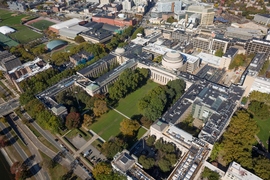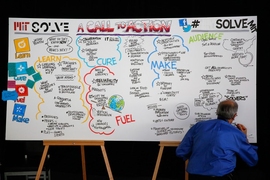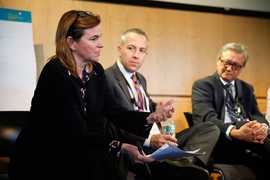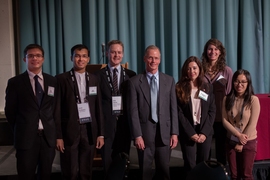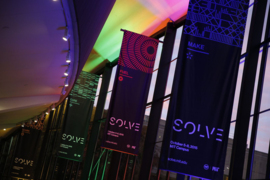At a kickoff event for the inaugural MIT Solve conference, Jeffrey Sachs, director of the Earth Institute at Columbia University, commented on the growing need for the world to apply scientific thinking to the world’s toughest problems. In a discussion of how to achieve the United Nations’ recently unveiled global sustainable development goals, Sachs said, “It’s not a dream, it’s an architecture. It’s about how and why we act, and how to change it.” At Solve, thought leaders from across the nation and the world gathered at MIT to draw up new blueprints for that architecture. They began by planning how they would tackle the world’s greatest problems with a mix of critical thinking, imagination, and technology.
The issues at hand were organized under four pillars: “Cure” tackled the most pressing challenges in health care today; “Learn,” those in the education system; and “Make” those related to infrastructure and the economy. The “Fuel” pillar’s objective — “to double energy and food production, halve carbon output by 2050, and set a path to net-zero carbon emissions by 2100” — acknowledged the importance of improving quality of life in developing countries and protecting our environment while feeding a growing global population.
The Fuel pillar was moderated by MIT Energy Initiative (MITEI) Director Robert Armstrong and Angela Belcher, professor of biological engineering and of materials science and engineering at MIT. In his introduction setting the framework for Fuel, Armstrong emphasized the strong connection he feels exists between the MITEI and Solve’s mission statement: “AT MITEI, we feel that a collaborative approach is essential to making change. The key linkages that Solve seeks to create between like-minded individuals and institutions around the world will enable us to find inclusive solutions to global issues.” He identified seven elements in particular he considers important to what he called our current “energy revolution”: solar, storage, carbon capture and sequestration, nuclear, materials, the grid, and bioenergy.
At the kickoff roundtable panel for Fuel, leaders in the conventional energy industry focused on new horizons for energy and the need for sustainable and renewable energy solutions to meet growing energy demand in the developing world. Panelists also stressed the critical ties between energy issues and food and water issues. “Cheap renewable energy and clean water are critical to allowing the world to make, learn, and build,” one speaker said.
After this opening session, Fuel participants broke off into four parallel sessions on renewable energy, nuclear, climate, and food.
The renewable energy panel focused on pathways to worldwide implementation of advanced renewable energy sources. Frank O’Sullivan, director of research and analysis at MITEI, echoed Armstrong’s heralding of an energy revolution, elaborating: “It’s not just a revolution in respect to renewable energy or storage. The whole system is being turned upside down.”
Solar energy and storage were major themes of the renewables discussion. On the topic of solar, one researcher said, “The big opportunity in the solar field today is in reimagining why it needs to cost so much to make a solar cell.” He encouraged fellow researchers to “start reimagining the cells themselves, making them multi-layered, making them stacked.”
Another researcher commented on the promise and challenges of energy storage. “Today the biggest problem is not power with batteries — it’s reaching a high enough energy density while also keep costs down. Energy density translates to cost.” One of his suggestions was to vertically integrate production of new-era storage like lithium-ion batteries as a cost-cutting measure.
Cost was also a major factor in the nuclear panel. Several of the researchers and entrepreneurs representing nuclear startups made the case that reviving nuclear power is needed to help untangle the “Gordian knot” of simultaneously developing clean, low-cost, and secure energy supplies at a global scale. Discussions focused on how to make nuclear more cost-effective in the face of rising costs — costs attributed to the lengthy licensing process and to development expenses.
A lead presenter put these health concerns in perspective, citing “studies show[ing] that coal has historically caused many more deaths than nuclear.” The promise of new nuclear technologies and safer reactor designs was a unifying theme among the startup companies represented. There was also much discussion about whether the length and cost of the Nuclear Regulatory Commission’s licensing process is a bottleneck preventing timely implementation of such new technologies.
Capitalizing on new technology was also at the forefront of the climate panel. Panelists discussed challenges associated with current carbon capture and sequestration methods, such as cost and reliability, but also identified opportunities related to novel membranes and absorption processes.
Researchers also highlighted the need for climate resiliency. “Hurricane Sandy, with lives lost and massive destruction, was a wake-up call for New York City on climate change,” one researcher said. “Hurricane Joaquin luckily went out to sea this fall, but others will come.” As cities plan this climate resiliency, the need to “empower citizens and institutions to prepare” was discussed as a high priority. Kerry Emanuel, the Cecil and Ida Green Professor of Atmospheric Science, who spoke as a panelist, reflected that “the panel brought together key elements at MIT that define the climate problem and address potential solutions to it, which is very much in the spirit of the Solve program.”
The food panel was similarly enlivened by a sense of community and urgency. Panel attendee Markus Buehler, head of the Department of Civil and Environmental Engineering at MIT, noted the “great energy and intellectual vibrancy of discussions and commitment to the future” — including the future of agriculture in a world that will soon be faced with the challenge of feeding 10 billion people while still supporting the ecosystems that we rely on for clean water and air. “Enormous opportunities exist in the agriculture sector, where technologies could open the doors to solve grand challenge issues that include the carbon footprint and the emission of nitrogen,” he said. “One day we may look back at this point in time and appreciate the paradigm shift that is occurring about how we produce food under changing environmental conditions, similar to the way the industrial revolution changed how we manufacture.”
MITEI Executive Director Martha Broad commented on the “dedication to positive change” evident as the researchers discussed their work and visions for the future, calling the Solve program “an important convening of experts and a fascinating meeting of the minds.”
After the conclusion of the breakout panel discussions, Armstrong and Belcher reconvened the Fuel pillar for a public session with Ratan Tata, chair of the Tata Trust and chairman emeritus of Tata Sons, and Robert Stoner, director of the MIT Tata Center for Technology and Design. Before introducing Tata and Stoner, Belcher took a moment to express her “excitement about the engagement of the audience” in the panels. Armstrong added that in his panel session he observed several “interesting ideas about how government, academia, and industry can better work together.”
Tata and Stoner discussed the origins of the MIT Tata Center and its eventful first three years supporting research designed to have an impact in the developing world. Speaking of the Tata Trusts’ connection to the center’s work, Tata said that the Tata Trusts did not define the projects that the MIT Tata Center would focus on. “We looked [to] … the innovation of MIT and faculty scholars to address the problems they saw [in the developing world].” Stoner echoed this sense of innovation and positive energy in discussing how seemingly intractable challenges can yield to sustained effort: “We keep pushing on these walls where we think we’ll see resistance, but we’re making progress. The walls are receding.”
This kind of energy will be critical as participants funnel the momentum from this inaugural Solve conference into each becoming “local solvers,” which MIT President L. Rafael Reif says are the necessary antidote to our global challenges.
Note: All panels, with the exception of public sessions, were held under the Chatham House Rule, in order to foster an environment of candid, respectful exchange. Under Chatham House Rule, participants are free to use the information received, but neither the identity nor the affiliation of the speaker(s), nor that of any other participant, may be revealed. Quotes from private sessions are attributed in this article only with the speaker’s permission.


